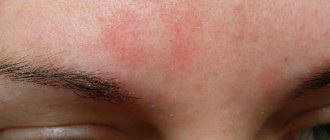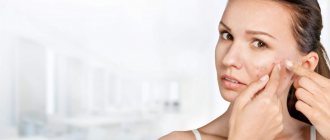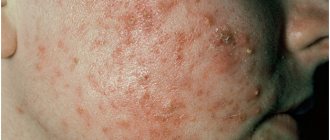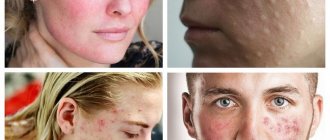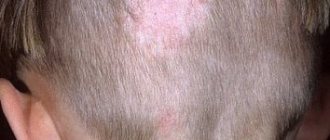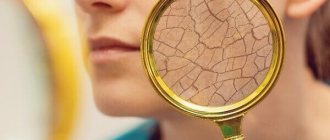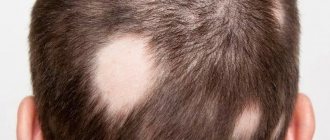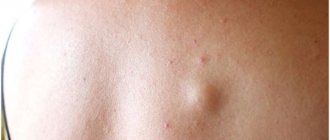Are you constantly embarrassed by others and cover your face with your hair in the hope of hiding skin imperfections? With early diagnosis and treatment of acne, your face can become clear and radiant again.
If you want to smile at your reflection in the mirror again, rather than look away in embarrassment, then this article is a must-read.
Acne is defined as a chronic skin disorder in which hair follicles become blocked and/or inflamed. When bacteria attaches to pimples, infection occurs and blackheads form. There are several variants of the disease, and they range from mild to severe. Appears on the face, neck, chest and back area.
Acne itself can cause not only psychological discomfort to its owner, but also lead to scarring of the skin (post-acne).
How papules and pustules appear
The mechanism of pimple formation is very simple. Due to the increased secretion of sebum - sebum - the sebaceous gland duct is blocked. A sebaceous plug is formed, that is, a comedon; they can be open or closed. But if such a comedon is affected by the bacteria P. Acnes, then inflammation occurs; over time, the purulent contents break into the skin, spread, which leads to the formation of other papules, and with more severe inflammation, purulent pustules appear.
There are many reasons for such activity of the sebaceous glands, the most common being hormonal changes during puberty. Nutrition, stress, hygiene habits, and lifestyle also play a role.
Causes of acne
You've probably heard the misconception more than once that acne is the result of poor hygiene. In reality, it is a complex skin condition involving hormonal, dietary and hereditary factors, and for all these reasons and more, acne requires a holistic approach. Treatment largely depends on the severity of the disease. If you have acne, never use alcohol or sulfates in hopes of freeing your skin from the unpleasant disease.
Acne can appear for the following reasons:
- Hormonal imbalance. With increased testosterone production in men and women, intense accumulation of sebum occurs in the glands. This turns out to be a favorable environment for the development of bacteria. Increased testosterone production in women may be associated with ovarian dysfunction. During adolescence (10-18 years), the formation of the endocrine system and puberty occurs. Often at this age, boys and girls experience active production of testosterone, which is what causes acne.
- Disorders of the autonomic nervous system. Frequent stress, lack of sleep, fatigue, increased physical activity, endocrine changes in the body (for example, after childbirth) lead to an imbalance in the work of the sympathetic and parasympathetic parts of the autonomic nervous system. In this case, again, the human sebaceous glands work more intensively.
- Decreased immunity. The skin's natural defenses can be disrupted by bad habits, stress, poor diet, and abuse of ultraviolet rays. As a result, bacteria and fungi multiply, causing acne.
- Hereditary predisposition. If parents have had acne, then there is a high chance that their children will also suffer from this problem. An increased level of testosterone, the level of sensitivity of the sebaceous glands to the effects of sex hormones, a tendency to form defective sebaceous glands, and much more can be inherited.
- Dietary disorder. Floury and sweet foods, as well as sugar, which is found in almost all foods, lead to the development of large amounts of insulin. As a result, the production of male sex hormone increases. And this, as we have already learned above, leads to increased production of sebum. The abundance of unhealthy fats in the body leads to the development of bacteria, which cause acne on the body and face.
- Diseases of the gastrointestinal tract, pathologies of the endocrine system. Acne is often a symptom of internal diseases. For example, diseases of the digestive system lead to the fact that food is not fully absorbed and stagnates. Acne is most often formed due to pathologies such as dysbiosis, constipation, irritable bowel syndrome, acute and chronic gastritis, and stones in the bile ducts.
- Incorrect cosmetic care. This includes failure to comply with personal hygiene rules and the use of low-quality decorative cosmetics. On the contrary, if the skin is constantly subjected to cleansing, it loses its natural protection and the acid-base balance is disturbed. As for low-quality cosmetics: viscous products that contain oils and glycerin are considered especially dangerous. Such cosmetics clog pores and create a microfilm on the surface of the skin that impedes breathing.
Acne
Acne is a disease in which papules, pustules, and comedones appear on the face and body (several follicles are affected at once). The inflammation is widespread, often the pimples are painful to touch, and as soon as one goes away, others appear. If a person has only comedones - white and blackheads, then we are talking about a non-inflammatory type of acne. And if there are papules and pustules, cysts, this is an inflammatory type. Pustules on the face should not be pressed, this will only worsen the situation; the contents may not break out, but subcutaneously.
It is worth saying that papules and pustules can appear not only as part of acne, for example, papular dermatosis with sterile papules is sometimes found, that is, P. Acnes is not detected in them, but acne is still the most common cause. Papular rashes also occur with psoriasis.
Acne treatment methods
If inflamed rosacea appears on your face and you feel a strong tingling sensation, then you should
Seek advice from our trusted specialists! Since even simple acne can develop into a more unpleasant disease - rosacea.
Doctors will be able to provide all the important information on combating pathology and will carry out safe procedures in the shortest possible time. With timely diagnosis and treatment, your face will become clear and radiant again.
For a long time there was no most effective and rapid treatment for the disease. As a rule, an integrated approach is always used. It involves the work of several specialists at once: a dermatologist, a nutritionist, a surgeon. Treatment occurs in several stages:
- prevent the formation of comedones;
- clear clogged ducts;
- stop the proliferation of bacteria;
- reduce sebum secretion;
- cure inflammation on the skin.
Those with this unpleasant disease took antibiotics, used ointments, and followed a diet. This approach did not always help, but could only do harm. In modern cosmetology, a new effective means for treating acne has appeared - light and laser technologies.
How to treat papules and pustules
Now that we have found out what papules and pustules are, the question arises whether they need to be treated. In this case, everything depends on their number and frequency of occurrence. If they are isolated and rarely appear on the face and body, for example, due to hormonal changes during the menstrual cycle, then there is no need to worry. You can simply choose suitable care cosmetics from a cosmetologist and cleanse your face efficiently. But if there are a lot of rashes, they can merge together and form spots; papules and pustules should be treated by a dermatologist.
Treatment of acne, papules and pustules is complex.
Lifestyle adjustments and adherence to doctor's recommendations are required. A non-hormonal ointment is used as a local remedy, which does not cause withdrawal effects in the future. Before treatment, the doctor will prescribe tests for hormones, the content of certain vitamins and a general blood test. This way you can choose an individual treatment plan. June 23, 2020
Author of the article: dermatologist Mak Vladimir Fedorovich
Papules after biorevitalization: what is it?
Papules are small elevations above the skin level that contain a gel-like composition with hyaluronic acid. They appear due to the fact that the drug is injected to a shallow depth. The formation of papules is a feature of biorevitalization, in contrast to similar cosmetic procedures. This is a natural skin reaction that is not a pathology, although it scares many.
If there are no papules after biorevitalization, this may indicate:
- disrupted technology (the drug was injected very deeply);
- low density of the substance (HA is diluted with other components);
- excessive dryness of facial skin, imbalance of water balance;
- large thickness of the dermis.
The size of the resulting papules depends on the angle of the needle entering the skin, the composition of the hyaluronic acid-based product and the area of treatment. For example, in the décolleté area the diameter of the tubercles is usually 3 mm, while in the periorbital area it is no more than 1 mm.
How many days will it take for the papules to resolve?
Within a few hours after the procedure, the papular tubercles noticeably increase (up to 30%), and then the drug begins to gradually be absorbed with their smoothing. It is impossible to say exactly how long papules last after biorevitalization, because everything depends on the characteristics of the body. The average period is 2-3 days, the maximum is 10 days. But with good skin condition and a high ability to regenerate, the tubercles become barely noticeable or disappear completely already on the 3rd day after the procedure. Those with sensitive skin should immediately prepare for a longer recovery period.
The cosmetologist can give an approximate time taking into account the following factors:
- skin density at the treatment site;
- thickness of the surface layer of the epidermis;
- degree of hydration of dermal cells;
- circulatory and lymph flow activity.
Symptoms
Structurally, the nodules are bandless formations of various colors. They can be red, gray, brown. Some papules have a noticeable bubble on the surface; they are called serous. Red formations are usually inflammatory in nature.
The size of a single growth can vary: from the head of a pin to the size of a nail. Large papules are called plaques.
In addition to the external defect, papules can cause physical discomfort, causing itching, inflammation, burning sensation and irritation of the skin. When pressed, the formations turn pale.
The appearance of unpleasant growths on the skin always makes you want to get rid of them as quickly as possible. But not all patients seek help from a doctor, and many self-medicate. Such therapy not only does not eliminate the defect in appearance, but can serve as a favorable condition for the further spread of infection.
In addition, papules can be symptoms of serious diseases that require immediate treatment.
Psoriasis. Treatment
Such a varied clinical picture of the disease makes diagnosis difficult - it is necessary to differentiate psoriasis from a significant number of diseases (for example, lichen planus, syphilis, seborrheic dermatitis, atopic dermatitis , rheumatoid arthritis , etc.).
Remember that the slightest peeling or redness of the skin cannot be ignored - these may be symptoms of psoriasis and other dermatological diseases that will progress without treatment. Experienced dermatologists at our clinic will conduct the necessary research and make the correct diagnosis.
Treatment of psoriasis is aimed at eliminating the inflammatory process and includes a whole range of therapeutic measures. Today there are many methods and drugs for the treatment of poriasis. When prescribing therapy, it is important to take into account the prevalence of skin lesions, the form and stage of the disease, the characteristics of the process, the presence of concomitant diseases, etc.
The comprehensive treatment program for psoriasis includes general and local therapy, the prescription of antihistamines, physiotherapeutic methods, etc.
Local drug therapy (using products containing sulfur, naphthalan, tar and other components) is aimed at reducing inflammation and peeling of the skin.
In the progressive stage, glucocorticosteroids are prescribed, the use of which has a number of restrictions and should be prescribed exclusively by a specialist. Thus, the use of strong glucocorticosteroids is associated with a high risk of withdrawal syndrome, which is expressed in a sharp exacerbation of the process. Self-medication with such drugs can lead to atrophy, swelling of the skin, etc.
1 Excilite µ system
2 Excilite µ system
3 Excilite µ system
We know how to treat psoriasis! The MedicCity clinic uses the latest Excilite excimer laser system. Unique equipment makes it possible to achieve stable remission of the disease and a significant reduction in the manifestations of psoriasis.
It is very important to start treating psoriasis as early as possible! You can check prices for a course of procedures with the clinic administrator or by phone!
1 Excilite µ system
2 Excilite µ system
3 Excilite µ system
Treatment of psoriasis using the Excilite system is based on exposure of the affected area to monochromatic radiation with a wavelength of 308 nm. There is a targeted phototherapeutic effect on pathological cells. The effectiveness of treatment is 90%! Positive results are noticeable after just a few procedures. Rapid healing of inflammatory foci and removal of plaques occurs. Moreover, the procedures are painless, comfortable, and have no side effects.
1 Excilite µ system
2 Excilite µ system
3 Excilite µ system
In the treatment of psoriasis, it is also important to follow a special diet, special skin care (the use of moisturizing, skin-softening creams, etc.), spa treatment, the use of vitamin therapy, etc.
In addition, it is necessary to correct concomitant diseases of the gastrointestinal tract, nervous system, hormonal sphere, etc.
The material was prepared with the participation of a specialist:
